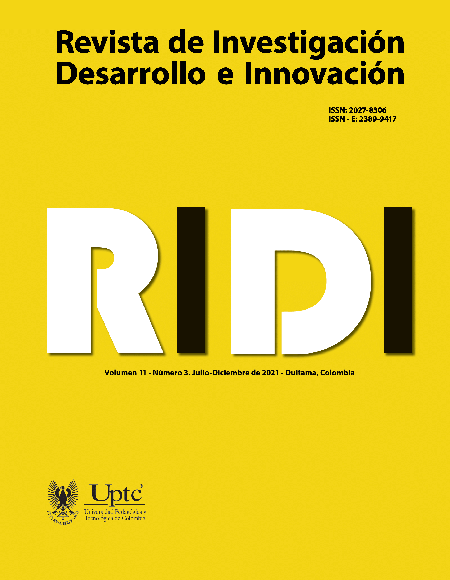Effects of technological cooperation on the innovative activity of the colombian manufacturing sector

Abstract
The purpose of this research was to analyze the effect that technological cooperation with business partners and knowledge organizations, both national and foreign, has on the development of technological and non-technological innovation in companies in the Colombian manufacturing sector. A research with a quantitative approach was carried out, in which secondary information from 1.845 manufacturing companies was used, collected in the IX survey of Technological Development and Innovation of Colombia. The results indicate that cooperation with national companies has a greater effect on product and process innovation, while cooperation with national knowledge organizations contributes more to organizational innovation. It is also found that market innovation is not influenced by any type of cooperation, and that international cooperation has no effect on any type of innovation. It is concluded that the types of innovation have different determinants that favor their achievement, therefore, the decision to carry out technological cooperation must start from the definition of the business strategy and the knowledge of the contribution that each type of partner can make to it.
Keywords
innovation, technology cooperation, manufacturing sector, international technological cooperation
Author Biography
Yury Yohana Castillo-Molina
Administradora de Empresas, Estudiante de Doctorado en Economía y Gestión de la Innovación
Cesar Augusto Gómez-Villamarín
Administrador de Empresas, Magíster en Economía y Gestión de la Innovación
References
- Álvarez, I., Natera, J. M., & Castillo, Y. (2019). Generación y transferencia de ciencia, tecnología e innovación como claves de desarrollo sostenible y cooperación internacional en América Latina. Documentos de Trabajo, 2019. https://doi.org/10.33960/issn-e.1885-9119.dt19
- Barroso-Simao, L., Gouveia-Rodrigues, R., & Madeira, M. J. (2016). External relationships in the organizational innovation. RAI Revista de Administração e Inovação, 13 (3), 156–165. https://doi.org/10.1016/j.rai.2016.06.002
- Castillo-Vergara, M., & Torres-Aranibar, E. (2019). El papel de la Cooperación para Desarrollar Innovación Tecnológica en la PYME. Journal of Technology Management & Innovation, 14 (4), 41–53. https://doi.org/10.4067/s0718-27242019000400041
- Cheng, C. C. J., & Huizingh, E. K. R. E. (2014). When is open innovation beneficial? The role of strategic orientation. Journal of Product Innovation Management, 31 (6), 1235–1253. https://doi.org/10.1111/jpim.12148
- Cheng, C., & Shiu, E. (2015). The inconvenient truth of the relationship between open innovation activities and innovation performance. Management Decision, 53 (3), 625–647.
- DANE. (2019). Boletín Técnico EDIT 2017 - 2018. 1–60. https://www.dane.gov.co/files/investigaciones/boletines/edit/boletin_EDIT_manufacturera_2017_2018.pdf
- Díaz, L., Aguilar, I., & De Saá-Pérez, P. (2006). El conocimiento organizativo tecnológico y la capacidad de innovación. Evidencia para la empresa industrial española. Cuadernos de Economía y Dirección de La Empresa, 33–59. http://www.redalyc.org/pdf/807/80702702.pdf
- Geldes, C., Felzensztein, C., & Palacios-Fenech, J. (2017). Technological and non-technological innovations, performance and propensity to innovate across industries The case of an emerging economy. Industrial Marketing Management, 61, 55–66. https://doi.org/10.1016/j.indmarman.2016.10.010
- Geldes, C., & Heredia, J. (2016). Cooperación: un tema pendiente para la innovación empresarial. Gestión y Tendencias, 1 (6), 6–9.
- Global Innovation Index. (2019). Global Innovation Index 2019. Organización Mundial de la Propiedad Intelectual. https://www.globalinnovationindex.org/gii-2016-report#
- Gomez, F. A., Daim, T. U., & Robledo, J. (2014). Characterization of the relationship between firms and universities and innovation performance: The case of Colombian firms. Journal of Technology Management and Innovation, 9 (1), 70–83. https://doi.org/10.4067/S0718-27242014000100006
- Hagedoorn, J. (1993). Understanding the rationale of strategic technology partnering: Nterorganizational modes of cooperation and sectoral differences. Strategic Management Journal, 14 (5), 371–385. https://doi.org/10.1002/smj.4250140505
- Heredia-Pérez, J. A., Geldes, C., Kunc, M. H., & Flores, A. (2019). New approach to the innovation process in emerging economies: The manufacturing sector case in Chile and Peru. Technovation, 79, 35–55. https://doi.org/10.1016/j.technovation.2018.02.012
- Hervas-Oliver, J. L., Sempere-Ripoll, F., Boronat-Moll, C., & Estelles-Miguel, S. (2020). SME open innovation for process development: Understanding process-dedicated external knowledge sourcing. Journal of Small Business Management, 58 (2), 409–445. https://doi.org/10.1080/00472778.2019.1680072
- Huang, S., Chen, J., & Liang, L. (2018). How open innovation performance responds to partner heterogeneity in China. Management Decision, 56 (1), 26–46. https://doi.org/10.1108/MD-04-2017-0452
- Kim, Y., & Lui, S. S. (2015). The impacts of external network and business group on innovation: Do the types of innovation matter? Journal of Business Research, 68 (9), 1964–1973. https://doi.org/10.1016/j.jbusres.2015.01.006
- Lin, J. Y. (2017). Balancing industry collaboration and academic innovation: The contingent role of collaboration-specific attributes. Technological Forecasting and Social Change, 123, 216–228. https://doi.org/10.1016/j.techfore.2016.03.016
- Miotti, L., & Sachwald, F. (2003). Co-operative R&D: Why and with whom? An integrated framework of analysis. Research Policy, 32 (8), 1481–1499. https://doi.org/10.1016/S0048-7333(02)00159-2
- Mol, M. J., & Birkinshaw, J. (2009). The sources of management innovation: When firms introduce new management practices. Journal of Business Research, 62 (12), 1269–1280. https://doi.org/10.1016/j.jbusres.2009.01.001
- Moura, D. C., Madeira, M. J., & Duarte, F. A. P. (2020). Cooperation in the field of innovation, absorptive capacity, public financial support and determinants of the innovative performance of enterprisE. International Journal of Innovation Management, 24 (4), 2050038. https://doi.org/10.1142/S1363919620500383
- Nieto, M. J., & Santamaría, L. (2007). The importance of diverse collaborative networks for the novelty of product innovation. Technovation, 27 (6–7), 367–377. https://doi.org/10.1016/j.technovation.2006.10.001
- Sánchez-González, G. (2014). Efectos de la cooperación sobre el desarrollo de innovaciones organizativas. Economía Industrial, 391, 77–86.
- Serrano-Bedia, A. M., López-Fernández, M. C., & García-Piqueres, G. (2018). Complementarity between innovation knowledge sources: Does the innovation performance measure matter?. BRQ Business Research Quarterly, 21 (1), 53–67. https://doi.org/10.1016/j.brq.2017.09.001
- Tello-Gamarra, J., Leo, R. M., Avila, A. M. S., & Wendland, J. (2018). Innovation studies in latin america: a bibliometric analysis. Journal of Technology Management and Innovation, 13 (4), 24–36. https://doi.org/10.4067/S0718-27242018000400024
- Whitley, R. (2002). Developing innovative competences: The role of institutional frameworks. Industrial and Corporate Change, 11(3), 497–528. https://doi.org/10.1093/icc/11.3.497
- Zanello, G., Fu, X., Mohnen, P., & Ventresca, M. (2016). the Creation and Diffusion of Innovation in Developing Countries: a Systematic Literature Review. Journal of Economic Surveys, 30 (5), 884–912. https://doi.org/10.1111/joes.12126